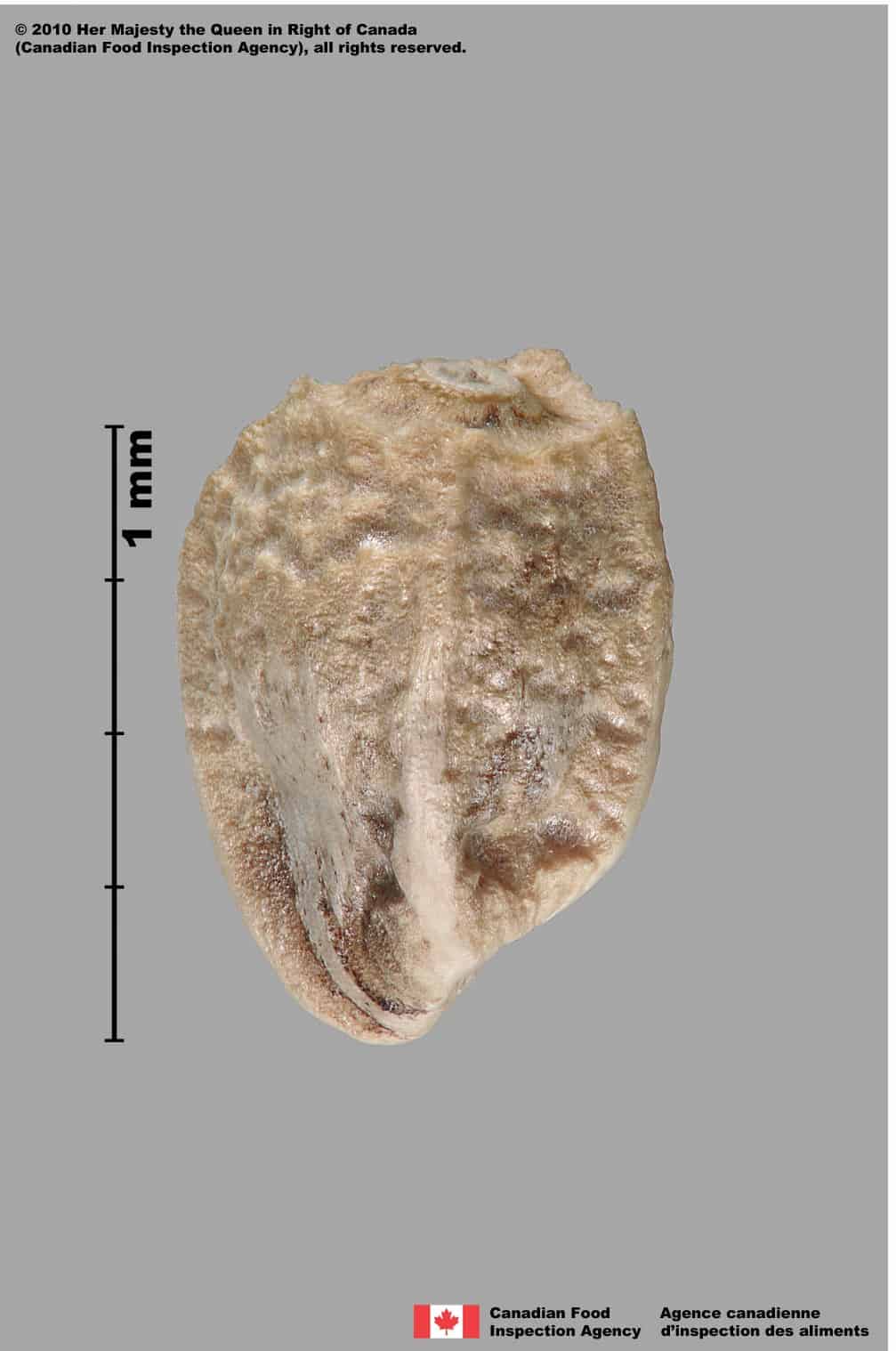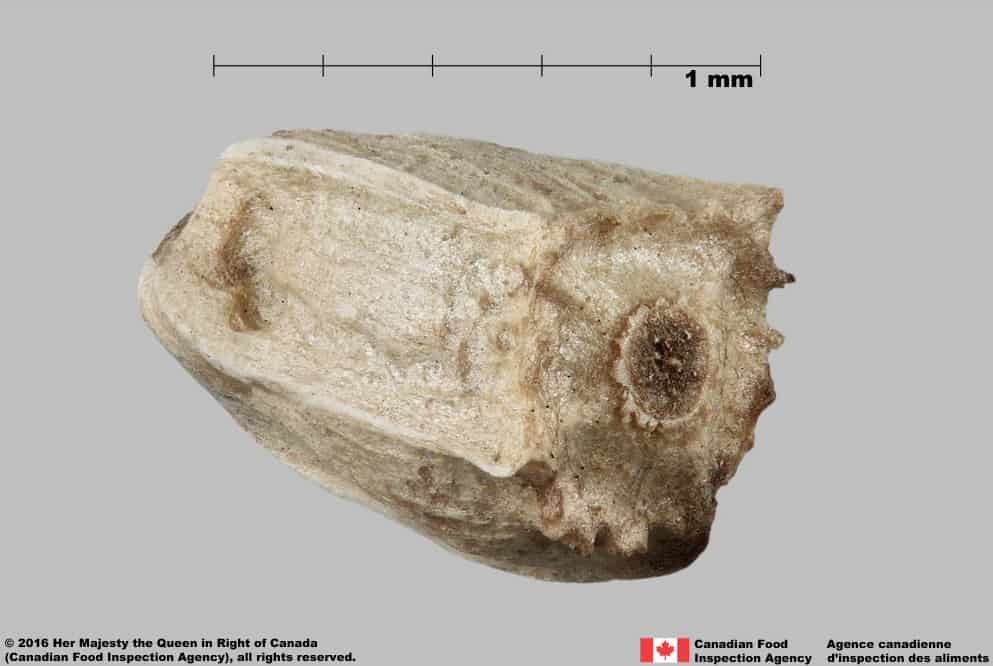Carthamus lanatus
Overview
Aperçu
Regulation :
Remarques Réglementation:
- Quarantine lists of countries e.g. Mexico *may be updated without notice
Regulation Notes:
On quarantine lists of countries e.g. Mexico*.
*Quarantine lists of countries may be updated without notice.
Distribution :
Répartition :
This species is native to Africa temperate Asia, and Europe. It is naturalized in Australasia and North America (USDA-ARS 2017). In the United States, it occurs in the western states and in South Carolina (USDA-NRCS 2017).
Habitat and Crop Association :
Habitat et Cultures Associées :
Grows in fields, rangelands and roadsides (FNA 2017).
Economic Use, cultivation area, and Weed Association :
Utilisation économique, zone de culture et association de mauvaises herbes :
Duration of Life Cycle :
Durée du cycle vital:
Annual
Dispersal Unit Type :
Type d’unité de dispersion :
Achene
General Information
RENSEIGNEMENTS GÉNÉRAUX
This noxious weed can severely degrade infested rangelands (FNA 2017).
.
Flowering Carthamus lanatus (Joseph M. DiTomaso, University of California – Davis, Bugwood.org)
Identification
Identification
-
Achene
Size
- Achene length: 4.0 – 5.1 mm (average: 4.5 mm); width: 2.3 – 3.5 mm (average 2.7 mm)
Shape
- Achene is an angular egg-shape with a flat broad end and a side notch at the narrow end
- Achene is slightly compressed
Surface Texture
- Achene surface wrinkled or scarified, but smooth near the side notch
- The achene has four long ribs: on the two edges and the two compressed sides; ribs are smooth
Colour
- Slightly shiny, whitish to brown- coloured achene
- Pappus bristles are whitish to light brown coloured
Other Features
- A pappus at top of achene may be present, made up of flattened bristles
- A short style appendage is in the flat area at the broad end of the achene, surrounded by a jagged collar

Woolly distaff thistle (Carthamus lanatus) dimorphic achenes





Identification Tips
CONSEILS POUR L’IDENTIFICATION
Additional Botany Information
AUTRES RENSEIGNEMENTS BOTANIQUES
Similar Species
ESPÈCES SEMBLABLES
Similar species are based on a study of seed morphology of various species, and those with similar dispersal units are identified. The study is limited by physical specimen and literature availability at the time of examination, and possibly impacted by the subjectivity of the authors based on their knowledge and experience. Providing similar species information for seed identification is to make users aware of similarities that could possibly result in misidentification.
Carthamus dentatus (toothed thistle)
Carthamus dentatus achenes are a similar angular shape, with a side notch, pale colour, ribbed surface and flattened pappus bristles. Toothed thistle achenes are generally larger (average length: 5.0 mm; average width: 3.8 mm) have a smooth, dull surface, with a brown, wrinkled area around broad end of the achene.
Carthamus tinctorius (safflower)
Carthamus tinctorius achenes are a similar angular shape, with a side notch, pale colour, ribbed surface and flattened pappus bristles.
Carthamus tinctorius achenes are generally larger (average length: 7.7 mm; average width: 4.2 mm), whitish-coloured, and the surface is smooth and glossy with wrinkling only near the broad end. The pappus rarely persists in safflower achenes.
Click to select species
Cliquez pour sélectionner les espèces

Carthamus dentatus

Carthamus tinctorius
Comparison Window
Fenêtre de comparaison
MAIN SPECIES
ESPÈCES PRINCIPALES
Carthamus lanatus

Carthamus lanatus
Asteraceae
Woolly distaff thistle (Carthamus lanatus) achene from inner florets
MAIN SPECIES
ESPÈCES PRINCIPALES
Carthamus lanatus

Carthamus lanatus
Asteraceae
Woolly distaff thistle (Carthamus lanatus) achene from outer florets; side view
MAIN SPECIES
ESPÈCES PRINCIPALES
Carthamus lanatus

Carthamus lanatus
Asteraceae
Woolly distaff thistle (Carthamus lanatus) achene from outer florets
MAIN SPECIES
ESPÈCES PRINCIPALES
Carthamus lanatus

Carthamus lanatus
Asteraceae
Woolly distaff thistle (Carthamus lanatus) dimorphic achenes
MAIN SPECIES
ESPÈCES PRINCIPALES
Carthamus lanatus

Carthamus lanatus
Asteraceae
Woolly distaff thistle (Carthamus lanatus) dimorphic achenes
SIMILAR SPECIES
ESPÈCES SEMBLABLES
Carthamus dentatus

Carthamus dentatus
Asteraceae
Toothed thistle (Carthamus dentatus) achenes
SIMILAR SPECIES
ESPÈCES SEMBLABLES
Carthamus dentatus

Carthamus dentatus
Asteraceae
Toothed thistle (Carthamus dentatus) achene
SIMILAR SPECIES
ESPÈCES SEMBLABLES
Carthamus dentatus

Carthamus dentatus
Asteraceae
Toothed thistle (Carthamus dentatus) achene
Need ID Help?
Besoin d’aide pour l’identification?
Reference(s)
Référence(s)
Flora of North America (FNA) Editorial Committee, eds. 1993+. Flora of North America North of Mexico [Online]. 22+ vols. New York and Oxford. http://beta.floranorthamerica.org. Accessed April 25, 2017.
Flora of North America (FNA) Editorial Committee, eds. 1993+. Flora of North America North of Mexico [Online]. 22+ vols. New York and Oxford. Accessed December 29, 2022.
Global Biodiversity Information Facility (GBIF) Secretariat. 2022. https://doi.org/10.15468/39omei Accessed via https://www.gbif.org/species/3138230 Accessed December 29, 2022.
U.S. Department of Agriculture-Agricultural Research Services (USDA-ARS). 2017. Germplasm Resources Information Network (GRIN), https://npgsweb.ars-grin.gov/gringlobal/taxon/taxonomysearch Accessed April 25, 2017.
U.S. Department of Agriculture-Natural Resources Conservation Service (USDA-NRCS). 2017. The PLANTS Database. National Plant Data Team, Greensboro, NC USA. https://plants.usda.gov/home Accessed April 25, 2017.




